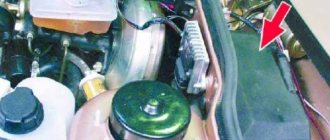General information.
Chargers of the Kulon-715 , Kulon-707 are designed for charging batteries used in cars, motorcycles, boats, etc. The devices have an additional operating mode – power supply.
Chargers of the Kulon with index A have a battery charging mode with the ability to set the maximum charging current, have an analog dial indicator of the charging current and manual adjustment of the charging current. Devices with index A can be used as a power supply with a voltage of 13.5 ± 1.5 V.
Chargers of the Pendant with the d have a digital liquid crystal display that displays the charging current and voltage, manual adjustment of the charging current and maximum voltage. Additional information is displayed in the creeping line. Devices with index d can be used as a regulated power supply.
The operating algorithm of chargers in this series implements a combined method of charging the battery (operation in current stabilizer mode in the main charge phase with switching to voltage stabilization mode in the final phase), which ensures automatic maintenance of the optimal charging speed, preventing overvoltage that is dangerous for the battery, leading to boiling of the electrolyte.
The charger has an electronic protection circuit that protects the device and battery from overloads and short circuits.
Device "Pendant 405"
The original “Pendant 405” charger is equipped with a digital display. “Pendant 405” is capable of charging a battery, as well as bringing a completely discharged battery back to life. The device can charge systems:
Moreover, the battery capacity should be within 1120 Ah. Voltage: 612 volts. The “Pendant 405” charger can be used as a constant power source, which can be regulated.
The device can be used as a constant power supply for a car alarm. The charger has a special mode that maintains the charge level. It protects the battery from overcharging.
The electrical circuit of the “Pendant 405” includes a microcontroller whose task is to optimize the charging of various batteries.
Safety requirements.
2.1. Before using the charger, you must study this manual, as well as the rules for the care and use of rechargeable batteries.
2.2. ATTENTION! During the charging of the battery, explosive gases are released, so charging the batteries must be done in a well-ventilated area. It is prohibited to block the ventilation holes on the device body with foreign objects.
2.3. When using the charger, it is not allowed to open the device case while it is on. Before connecting the device to the network, make sure that the insulation of the power cord is not damaged.
2.4. Do not allow any liquids or small foreign objects to come into contact with the charger housing and the power cord.
2.5. The device should only be disassembled and repaired by a qualified technician from an accredited workshop.
2.6. During the charging process, the temperature of the device case may exceed the ambient temperature by up to 40? C.
2.7. The electrolyte is an aggressive substance. If acid gets on clothing, it must be washed with running water. If acid gets on your skin or eyes, immediately rinse the affected areas with running water and consult a doctor.
2.8. To prevent the formation of condensation inside the device, store it in a dry, well-ventilated area at an ambient temperature of 0 to 40? C and a relative humidity of no more than 80%. After leaving the device in unfavorable climatic conditions, before turning on the device should be kept for two hours in a dry and warm room.
Terms of Use.
Attention! Monitor the reliability of the connection of the wires and output terminals of the device, the reliability of the installation and the rating of the protective fuse. Failure to do so may result in heating of the output terminals, the fuse holder, and may cause the front panel of the unit to melt.
3.1. During charging, the battery and charger should be placed on a non-flammable surface, at a sufficient distance from sources of open flame and directed heat. The battery can be placed at the same level or higher and away from the charger. Conditions must be provided for normal thermal circulation and air ventilation at the work site.
3.2. The beginning of battery charging (the first 15 minutes) must be under constant supervision. When using the device as a power supply, periodic monitoring must be carried out.
3.3. The device is protected from incorrect connection of the battery by using a car fuse with the rating indicated on the front panel. It is not allowed to install a fuse of a higher rating.
3.4. Do not store other items in the cable compartment.
3.5. To increase the service life of the fan (in versions with an output current of 15 A), its proportional control is implemented depending on the output current. Fan noise and minor noise from the pulse converter are not a defect in the device.
3.6. To recharge an undismantled car starter battery with the engine not running (only if the vehicle manufacturer has permission) and taking into account additionally installed electrical equipment, you must strictly observe the mandatory measures for powering the charger and placing it in a clean, dry, ventilated place, and also follow the guidelines below the stated restrictions:
— Do not leave the workplace unattended;
- The battery terminal not connected to the chassis should be connected first, then connect the second wire to the car chassis. The charger can then be connected to the mains supply;
— After charging the battery, disconnect the charger from the power source. Then disconnect the charger from the chassis and then the other wire from the battery;
— Do not test run the engine with the charger connected.
3.7. The safe operating life of the device is at least 7 years. Periodically (at least once every 3 years) it is necessary to carry out servicing and cleaning of the device by a qualified specialist. During the post-warranty period, these checks are carried out on a paid basis.
Technical data.
Table 1.
| Parameter | Pendant-707 | Pendant-715 |
| Rated supply voltage | 220 V frequency 50 Hz | |
| Power consumed from the network at rated load | 130 ± 10 W | 260 ± 15 W |
| Rated load | 1.7 ohm | 0.9 ohm |
| Power consumed from the network without load, no more | 5 W | |
| Nominal battery capacity | 75 Ah | 150 Ah |
| Minimum battery capacity | 7.5 Ah | 15 Ah |
| Power consumed from the network when charging, no more | 150 W | 300 W |
| Effective value of current consumed from the network when charging | no more than 1 A | no more than 2 A |
| Maximum battery discharge current when there is no power | 40 mA for modification "A" 50 mA for modification “d” | |
| Nominal open circuit output voltage | 15.0 ± 0.2 V | |
| Adjusting the no-load output voltage of modifications “d” | 6.4 ± 0.6 V….. 15.0 ± 0.2 V | |
| Maximum output current | 7.0 ± 1.5 A | 15.0 ± 2.0 A |
| Minimum value of the set charging current | 0.7 A | 1.0 A |
| Discreteness of voltage and current readings of modifications “d” | 0.1 A and 0.1 V | |
| Overall dimensions of the case | 153 x 85 x 215 | |
Preparing the device for operation.
5.1. Unplug the power cord, which is located on the rear removable cover of the device. After removing it, the cover should be replaced to avoid damage to the fan if foreign objects enter.
5.2. Check by external inspection the device, the absence of moving objects in the housing, and the integrity of the insulation of the network cable.
5.3. Verify by external inspection that the replaceable fuse installed on the front panel is in good working order.
5.4. Connect the power cord to a known-good outlet. You will hear a faint acoustic noise when the device is running without the battery connected. If any signs of malfunction appear, disconnect from the power supply and contact the manufacturer for advice.
5.5. Checking the functionality of the device by closing the output terminals should be performed in the following sequence. Set the current and voltage regulator to the extreme left position. Close the alligator clips and connect the device to the power supply. By turning the current regulator, increase the output current to a value corresponding to the modification of the device (Table 1).
5.6. If you are confident that the charger is operating normally, the above checks can be carried out periodically.
Who makes
Coulomb is engaged in the production and development of modern chargers. The company was opened in the early 90s of the last century. The company's products are used in different directions:
- Starter battery charger.
- Ventilation systems.
- Air conditioners.
- Devices that perform remote monitoring.
- Checking the control operation.
Automatic chargers "Pendant" are assembled on the basis of the latest microprocessors. The company's engineers are developing a continuous production cycle for such devices. After approval of the new product concept, serial production begins.
For about 20 years, the company has been developing technological processes for the production of battery chargers. The range of these devices includes several types:
- Simple.
- Semi-automatic.
- Multifunctional.
Description of the operation of devices with the index “A”
6.1. If necessary, correct the zero position of the dial indicator using its mechanical compensator.
6.2. Set the current regulator to the minimum position.
6.3. Tighten the wires included with the charger securely, taking into account the color.
6.4. Connect, strictly observing the polarity, the alligator clips to the battery terminals. The positive terminal of the battery is connected with a red wire, the negative terminal of the battery is connected with a black wire to the black terminal of the charger.
6.5. Connect the charger to the mains.
6.6. By turning the current regulator to the right, set the maximum charging current in accordance with the instructions for the specific battery. In the absence of instructions, we recommend setting the maximum charging current to approximately 0.1 of the battery’s nameplate capacity (for a battery with a capacity of 55 A*hour, set the current to 5.5 A).
6.7. On partially discharged batteries and in case of some battery malfunctions (severe sulfation of the plates, internal break between the battery banks), when the battery does not accept a charge, it is possible that you will not be able to set the recommended charging current. In this case, we recommend setting the charging current to 0.03 A from the battery’s nameplate capacity - this charging mode promotes the resorption of sulfate, but lengthens the charging time.
6.8. If it is impossible to set the desired charging current, check the voltage on the battery with the charger connected and the current regulator on the charger set to the right position. If the voltage matches the charger limit voltage (14.9 ± 0.1 V), the battery is either fully charged or faulty.
6.9. During charging, the voltage on the battery increases and reaches the limiting voltage. After this, the charger begins to reduce the charging current. A typical characteristic of the charging mode of a 12-volt battery at the specified maximum current and rated voltage (for modifications “d”) is shown in Table 2.
Table 2.
| Output voltage, V | Output current, A | |
| Pendant-707 | Pendant-715 | |
| 0 … 12 | 7 ± 1,5 | 15,0 ± 1,5 |
| 12,0 … 14,5 | 6,5 ± 1,0 | 14,0 ± 1,5 |
| 14,6 … 15,0 | smooth decline | |
6.10. The battery charging process can be completed 3 hours after the charging current drops to a value of 0.01 of the battery capacity (for a 55 A*hour battery, this is a current of 0.55 A).
6.11. After charging the battery, disconnect the device from the power supply, and only then the connecting wires from the battery. To avoid shorting the battery and reduce sparking, first disconnect the black wire from the charger terminal, and only then the red clamp from the positive terminal of the battery, and then the wire from the red terminal of the device.
6.12. If you do not intend to disassemble the battery charging station, take measures in advance to prevent accidental short-circuiting of the connectors during subsequent use.
Manufacturing company
Pendant is engaged in the development and production of chargers. The company was founded in 1991. Since then, the company has been present on the Russian market, developing and producing chargers for starter batteries, automated air conditioning and ventilation systems, as well as various devices for remote monitoring and control. All digital and analog products are manufactured on the basis of modern microprocessors. The company's specialists perform a full production cycle of digital and analogue equipment. They develop a product concept and then put it into mass production. provides services for the production of custom electronic equipment and participates in some production programs of other companies. Has more than 20 years of experience in the development and production of chargers for starter batteries. All this time, the company's products are being improved, and more and more convenient and functional chargers are offered. The model range includes several lines of chargers, ranging from the simplest to the most advanced with the ability to connect to a home wireless network. Let's take a closer look at them.
Description of the operation of devices with the index “d”.
7.1. Set the current and voltage controls to the far left position.
7.2. Without connecting the output wires to the device, connect the charger to the power supply.
7.3 Use the voltage adjustment knob to set the required limiting voltage - the end-of-charge voltage of the battery. In subsequent actions, be careful not to change the production settings.
7.4. Unplug the charger.
7.5. Securely screw the wires included with the charger to the output terminals, taking into account the color.
7.6. Connect, strictly observing the polarity, the alligator clips to the battery terminals. The positive terminal of the battery is connected with a red wire, the negative terminal of the battery is connected with a black wire to the black terminal of the charger.
7.7. Connect the charger to the mains.
7.8. By turning the current regulator to the right, set the maximum charging current in accordance with the instructions for the specific battery. In the absence of instructions, we recommend setting the maximum charging current to approximately 0.1 of the battery’s nameplate capacity (for a battery with a capacity of 55 A*hour, set the current to 5.5 A).
7.9. On partially discharged batteries and in case of some battery malfunctions (severe sulfation of the plates, internal break between the battery banks), when the battery does not accept a charge, it is possible that you will not be able to set the recommended charging current. In this case, we recommend setting the charging current to 0.03 A from the battery’s nameplate capacity - this charging mode promotes the resorption of sulfate, but lengthens the charging time.
7.10. If it is impossible to set the desired charging current, check the voltage on the battery with the charger connected and the current regulator on the charger set to the right position. If the voltage corresponds to the limiting voltage you set, and the charging current is low, the battery is either fully charged or faulty.
7.11. During charging, the voltage on the battery increases and reaches the limiting voltage. After this, the charger begins to reduce the charging current. A typical current-voltage characteristic is shown in Table 2.
7.12. The battery charging process can be completed 3 hours after the charging current drops to a value of 0.01 of the battery capacity (for a 55 A*hour battery, this is a current of 0.55 A).
7.13. After charging, disconnect the device from the power supply, and only then the connecting wires from the battery. To avoid shorting the battery and reduce sparking, first disconnect the black wire from the battery terminal, then disconnect the black wire from the charger terminal, and only then the red clamp from the positive terminal of the battery, and then the wire from the red terminal of the device.
7.14. If you do not intend to disassemble the battery charging station, take measures in advance to prevent accidental short-circuiting of the connectors during subsequent use.
7.15. When using chargers with the index “d” together with a battery as an uninterruptible power supply, it is necessary to set the limiting voltage lower than when charging the battery once. To select the correct value, see the instructions for the battery.
Join the conversation
I am the owner of 2x d, but purchased at different times, and it turned out that they are different. Tell me if this is a malfunction, then what to look for.
The devices are equipped with an analog charge level indicator. No other product has this functionality.
Wi-Fi pendant The main feature of the charger is the integrated Wi-Fi wireless communication module. So the question is how to update the firmware in an earlier model? Allows you to restore a severely discharged battery. Voltage: volt.
Automatic mode allows beginners to charge their battery without manual setup. Thanks to this, the device can be connected to your home network and controlled through a regular browser. The device is able to restore operation even of a completely discharged battery.
Recommended Posts
True, the cunning Chinese have already mastered the trick, and they always offer a circuit for their devices, which in reality does not even come close to the original, so the presence of a circuit on the network is no longer a sign of a quality product. Wi-Fi pendant The main feature of the charger is the integrated Wi-Fi wireless communication module. The malfunction, according to the client, does not regulate the current. Where can I buy a power board for d? The last three charges of different batteries using the current adjustment knob, the maximum I can set is 1.5 amperes.
The maximum voltage is only 15.4. Rectifier The rather unusual implementation of the rectifier is puzzling. This value ensures a long shelf life. The device is capable of remotely controlling various electronic systems, such as a smartphone.
Therefore, when we had to deal with equipment that was non-standard for our profile, our first desire was to refuse non-core repairs. Where can I buy a power board for d? Rectifier The rather unusual implementation of the rectifier is puzzling. No other product has this functionality. The best Zu for batteries. Pendant 715d
Using chargers as a power supply.
8.1. Chargers models Kulon-707A , Kulon-715A can be used as a power supply with a fixed voltage of 15.0 V.
8.2. Chargers of the models Kulon-715 d , Kulon-707 d can be used as an adjustable power supply with an output voltage from 6.0 to 15.0 V. To set the voltage, you must disconnect the load from the output terminals and set the voltage regulator to the required value. Then set the current regulator to the minimum position (to the left). Connect the load and set the current limit with the current regulator until the voltage stabilizes. If the load is variable in nature, increase the limiting current so that at maximum power take-off, the voltage across the load does not drop. For safety reasons, we do not recommend always setting the maximum current for which the device is designed, because in the event of a short circuit in the load, this will lead to more severe consequences.
8.3. When using the charger as a power supply, avoid short circuiting the output wires.
Reviews
The most reviews on the Internet can be found about pendant chargers of the 707 and 715 series. Owners are attracted, first of all, by the good combination of price and quality. Among the advantages, users also note the low weight and compact dimensions of these chargers. Those who are encountering charging a car battery for the first time liked the fact that the device can operate in fully automatic mode. That is, I set it and forgot it, so as not to fool myself.
Those who often have to charge high-capacity batteries (for example, from trucks) rated the Pendant 715d device positively. This model provides a current of up to 15 amperes at the start of charging, which significantly reduces the process. Many users liked the display of information about the charging process on the liquid crystal display (for models with such a display).
There are practically no reviews on the use of the Pendant charger with gel and AGM batteries. Therefore, it is not yet possible to form an objective opinion about the use of chargers with these types of batteries.
There are also negative reviews regarding starter battery chargers manufactured by Balsat. In general, negative and positive reviews are divided in a ratio of 20 to 80. In negative reviews, users usually point out the unreliability of Coulomb devices. For some owners who left similar reviews, the charger failed within about 2-3 years.
Problems were also associated with the lack of polarity reversal protection. Some users write that they confused the polarity. As a result, the “charger” failed.
Recommendations for use.
9.1. We recommend charging the battery at room temperature, because... In a cold state, the battery's ability to accept a charge sharply decreases (internal resistance increases).
9.2. To quickly charge the battery, it is allowed to charge at the maximum possible current, however, for a more complete charge of the battery, we recommend setting the charging current to 1/10 of the battery capacity. However, maintenance-free batteries (without top-up plugs) are more critical to the increase in voltage during charging and therefore, during the charging process, when the voltage increases to the limit value, we recommend reducing the charging current.
9.3. When storing the battery for a long time without recharging, before using the battery, we recommend charging the battery with a low current (1/20 ... 1/30 of the battery capacity). When storing a battery for a long time, you need to take into account that the battery self-discharges, so every 2-3 months we recommend fully charging the battery.
9.4. Old batteries have a reduced ability to accept charge, so during the charging process the charging current drops quickly or the charging current does not reach the maximum value.
9.5. During the first 15 minutes of operation of the charger, thermal conditions stabilize. We recommend not leaving the workplace unattended during this period and, if necessary, adjust the charging current.
9.6. If thermal protection periodically triggers, which manifests itself as a sharp decrease in the charging current and its subsequent restoration, make sure that there are no obstacles to the ventilation of the charger housing.










